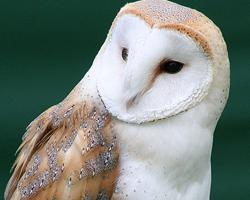
Váhy a míry
| Délka | od 29 do 44 cm |
|---|---|
| Hmotnost | od 300 do 650 g |
| Délka rozpětí křídel | od 80 do 90 cm |
Popis zvířete
The Barn Owl (Tyto alba) is a captivating bird of prey, known for its distinctive heart-shaped face, pure white underparts, and eerie, silent flight. This nocturnal raptor is found across a wide range of habitats including farmlands, woodlands, and even in urban areas, making it one of the most widespread of all birds, inhabiting every continent except Antarctica.Barn Owls possess a striking appearance; their upper parts are a mix of gold and gray, while their underparts are predominantly white, sometimes with speckles of black or brown. Their most remarkable feature is undoubtedly the heart-shaped facial disk, framed by a ring of feathers, which functions like a radar dish, channeling sound to their highly sensitive ears. This unique adaptation allows the Barn Owl to hunt with deadly precision, even in complete darkness.
The eyes of a Barn Owl are large and captivating, adapted for night vision, though not as powerful in the darkness as those of some other nocturnal predators. Instead, their hunting strategy relies heavily on their exceptional hearing, aided by the asymmetrical placement of their ears on their head. This slight offset enhances their ability to locate prey by sound alone, pinpointing the exact location of rodents rustling in the grass or beneath snow.
Barn Owls are silent hunters, their flight almost noiseless thanks to the specialized fringe on the leading edge of their wings and the soft, velvety texture of their feathers. This silent flight allows them to swoop down on unsuspecting prey, mostly small mammals like mice, voles, and shrews, which they swallow whole. Their diet can also include birds, insects, and bats, depending on their habitat and availability of prey.
Breeding season for Barn Owls is flexible, often dictated by the availability of food. They are cavity nesters, favoring hollow trees, cliffs, and abandoned buildings, including barns, which is how they got their name. A single pair can produce two to three broods per year in a good year, with each clutch containing up to six eggs. The female solely incubates the eggs while the male hunts, bringing food back to the nest.
Barn Owls communicate through a range of sounds, from the eerie screech that is often associated with bad omens in folklore to a softer, twittering call used between mates and their young. Despite their ghostly reputation, these owls play a crucial role in controlling rodent populations, making them beneficial to farmers and ecosystems.
Conservation status of the Barn Owl varies by region, with some populations facing threats from habitat loss, pesticide use, and road mortality. Conservation efforts focus on protecting nesting sites, erecting nest boxes, and encouraging practices that safeguard their natural habitats.
The Barn Owl, with its ghostly appearance, silent flight, and nocturnal habits, remains one of the most fascinating and widely recognized birds, embodying the mysterious beauty and complexity of the natural world.
Mapa výskytu

Nové fotografie zvířat
Top 10 zvířat
- Chinese water dragon (Physignathus cocincinus)
- Galápagos tortoise (Geochelone nigra complex)
- Dolphin gull (Leucophaeus scoresbii)
- Japanese macaque (Macaca fuscata)
- Colombian red howler (Alouatta seniculus)
- Sea urchins (Echinoidea)
- Moustached guenon (Cercopithecus cephus)
- Diana monkey (Cercopithecus diana)
- Common reed warbler (Acrocephalus scirpaceus)
- Common house mosquito (Culex pipiens)